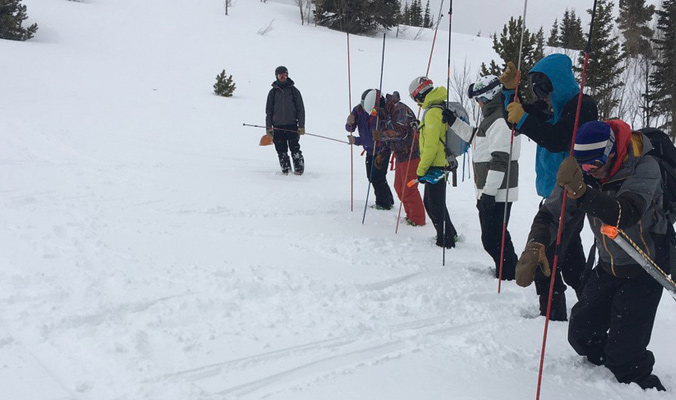This winter, avalanche education in the U.S. is evolving. The old system of Level 1, 2, 3 is currently being replaced with two options: a recreational track and one geared toward professionals. The goal of the split is to deliver better, more focused courses to each user group. So how do you know which one’s for you? Here’s the breakdown.

Avy class attendees practice a probe line. [Photo] Courtesy American Avalanche Institute
You belong on the recreational track. Take a Level 1 course, a rescue class and follow that up with Level 2. Don’t hesitate to explore other offerings as well. There are winter-weather forecasting courses, advanced rescue courses, refresher courses and first aid courses that are worthwhile for everyone traveling in the backcountry. If you’ve already taken your Level 2, take a refresher or a rescue course or attend a local snow and avalanche workshop in the fall.
Interested in working as a patroller, forecaster or guide?
Then head down the professional track. Start with the Level 1 course, just like everyone else. Take a rescue course and then move on to the Pro 1 and then Pro 2. And the supplemental offerings—the weather classes and pro-rescue classes—will help you in both your job and your personal touring.
What’s the main difference the pro and rec paths?
In the rec-level courses, we continue to talk about science, study the forecast and do stability tests in the field. We do less documentation work, and we focus more on efficient pits than full snow profiles.
In the professional courses, we are building and improving professional observers. We spend more time on recording data, interpreting that data and communicating that data. We continue to deliver useful tools such as efficient pits and good route finding in the field, and we geek out a bit more.
Why is this so complicated?
The previous structure—of Level 1, Level 2, Level 3—was a good system, but it wasn’t serving everyone as well as it could. Recreational backcountry users have different needs from professionals, and having courses that encompassed both audiences meant that everyone had to compromise in what they were learning. With the pro/rec split, we can more effectively serve both audiences and offer tools and information that make recreationists better touring partners and professionals better work partners.
What’s in it for me?
The new education system offers more courses to serve the entire population, whether you’re a seasoned ski patroller or new to ski touring. The advantage of the choose-your-own-adventure system is that recreational users don’t have to spend half a day in a study pit and can focus on efficient snow analysis and tools that they will be more likely to use with their partners. Professionals get focused coaching and training on a variety of skills that will help make them better observers, which adds to job performance.
Bottom Line: The split in avalanche education is confusing at first glance, but the goal is to better serve you, the backcountry user, and to encourage you to take advantage of increased opportunities for education.
—
Sarah Carpenter is the co-owner of the American Avalanche Institute and an AMGA-certified ski guide. Her first job out of college was ski patrolling at Bridger Bowl, Mont., and she’s been working in the snow and avalanche industry ever since as a patroller, ski guide and avalanche educator.
This article was originally published in January, 2018.










the main difference is note-taking, and price. rec-level courses should be much cheaper than certification courses. the hard skills are the same, and mind-numbing repetition and experience in the field ultimately dictate how safe/effective you are in the snow, no matter how much money you spend or classes you take.